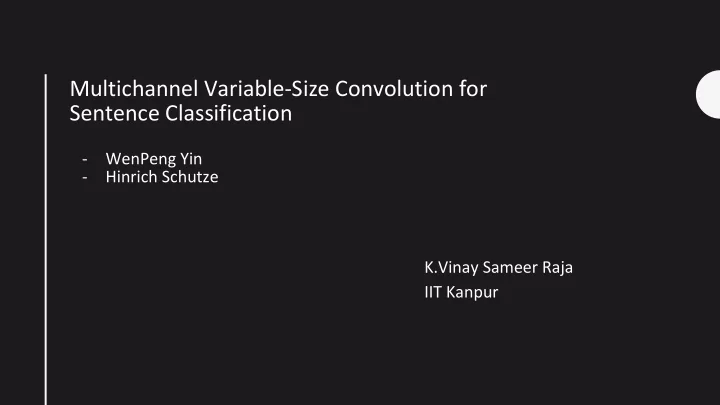

Multichannel Variable-Size Convolution for Sentence Classification - WenPeng Yin - Hinrich Schutze K.Vinay Sameer Raja IIT Kanpur
INTRODUCTION Enhance word vector representations by combining various word embedding ● methods trained on different corpus Extract features of multi granular phrases using variable filter size CNN. ● CNN's were employed for extracting features over phrases but the size of filter ● is a hyperparameter in such models Mutual learning and Pre training for enhancing MVCNN. ●
ARCHITECTURE Multi-Channel Input : Input layer is a 3 dimensional array of size c×d×s ● where s - sentence length d - word embedding dimension, c - no.of embedding versions. In practice while using mini batch, sentences are ● padded to same length by using random initialization for unknown words in corresponding versions .
Convolution Layer : The computations involved in this layer are same as those in normal CNN's ● but with additional features obtained due to variable filter sizes. Mathematical Formulation : ● Denoting feature map in i th layer by F i and assume there are n maps in i- ● j,k then 1 layer. Let l be the size of filter and let weights be in a matrix V i,l j = ∑ k V i,l j,k ∗ F i-1 k F i,l ∗ is the convolution operator
Pooling Layer : Normal k-max pooling involves storing k maximum values from a ● moving window. Dynamic k-max pooling has the k value changing for each layer. ● The choice of k value for a feature map in layer i is given by ● k i = max ( k top , ⌈ (L-i) * s / L ⌉ where i ∈ {1, . . . L} is the order of convolution layer from bottom to top L - total number of layers k top - a constant determined empirically which is the k value used in top layer
Hidden Layer : On the top of final k-max pooling a fully connected layer is stacked ● to learn sentence representation of required dimension d Logistic Regression Layer : The outputs of hidden layer are forwarded to logistic regression ● layer for classification
MODEL ENHANCEMENTS : Mutual Learning of Embedded versions : As different embedding versions are trained in different corpuses, ● there may be some words which don’t have embedding across all versions. Let V 1 , V 2 , … . V c are vocabularies of c embedding versions. ● V * = ∪ i=1 c V i be the total vocabulary of our final embedding - = V * \ V i is the set of word which have no embedding in V i V i V ij = overlapping vocabulary between i th and j th versions. We project (or learn) embeddings from i th to j th version by w ′ j = f ij (w i )
Squared error between w j and w’ j is the training loss to minimize ● Element-wise average of f 1i (w 1 ), f 2i (w 2 ), . . ., f ki (w k ) is treated as the ● representation of w in V. A total of c(c-1) /2 number of projections are calculated for finding ● embeddings of every word across all versions.
Pre- Training In Pre-training the “sentence representation” is used to predict the ● component words (“on” in the figure) in the sentence (instead of predicting the sentence label Y/N as in supervised learning) Given sentence representation s ∈ R d and initialized representations of 2t ● context words (t left words and t right words): w i − t , . . ., w i − 1, w i +1, . . ., w i +t ; w i ∈ R d , we average the total 2t + 1 vectors element wise Noise-contrastive estimation (NCE) is used to find true middle word from ● the above resulting vector which is predicted representation.
In pre-training initializations are needed for ● 1. Each word in sentence in multi-channel input layer (multichannel initialization) 2. Each context word as input to average layer (random initialization) 3. Each target word as the output of NCE layer (random initialization) During pre-training , the model parameters will be updated in such a ● way that they extract better sentence representations . These model parameters are fine tuned in supervised tasks.
RESULTS :
Datasets : Standard Sentiment Treebank (Socher et al., 2013) - Binary and Fine grained Sentiment140 (Go et al., 2009) - Senti 140 Subjectivity classification dataset by (Pang and Lee, 2004) - Subj
Questions ? Thank You!
Recommend
More recommend